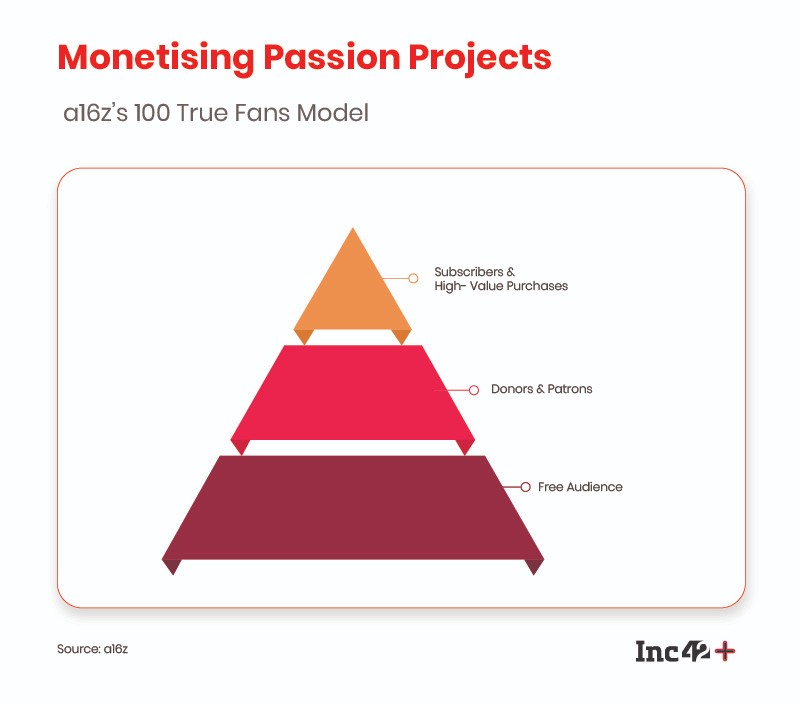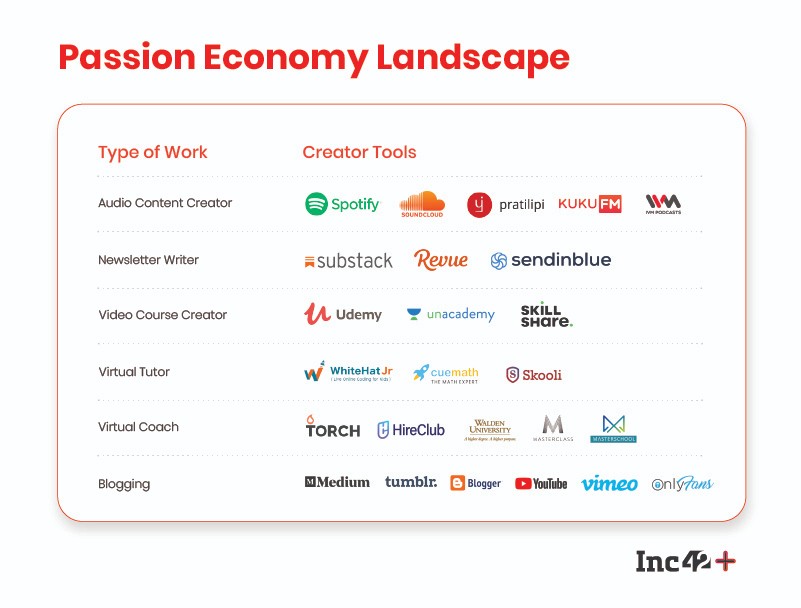Creators and experts are following their heart as digital platforms empower the passion economy
Hey Patron,
Over the past few months, many of us have found ourselves with slightly more time at our hand than before. The lockdown has brought out the children in many of us, as adults dusted off their hobbies and got back to their original interests and passions. Along the way, some even realised that these days it’s far easier to think about making a living by following your passion.
The digital world has transformed the hobbyist market into something more driven, what many are calling the passion economy. Here expertise, interests and hobbies are being thrown under the spotlight, helping create a wave of passionate self-made entrepreneurs in a range of subjects. This passion economy stretches from experts conducting online fitness or dance classes to curated newsletters to podcasts and vlogging collabs to content pieces such as videos or expert articles.
With the emergence of the passion economy has come a new wave of growth for platforms such as Substack, Patreon, OnlyFans, Masterclass, MasterSchool, Medium, upGrad, Unacademy as well as mainstream options like Twitch for gamers, Spotify for podcasters and YouTube and Vimeo for creators who want the largest reach.
Medium, Patreon, Substack and others have made it dramatically easier for even luddites to start their own digital publication, without any coding knowhow. While Blogger and other blogging platforms have existed for decades, the ease of customising a publication and tailoring the content for the audience is several degrees greater with Medium and Substack. This has lowered the entry barrier significantly to publish online content.
While the gig economy commoditised your skills, passion economy is focussing on monetising your individuality and personality. For instance, GOQii founder Vishal Gondal hosts the podcast ‘The Vishal Gondal Show’, historian/investment consultant Vedica Kant and engineer Anmol Maini co-write a newsletter (‘Keeping Up With India’), and veterans in the corporate world, Kaushik Subramanian and Anupriya Singhal run a blog (gyaanokplease.com) on the consumer market geared towards helping MBA students.
Perhaps unsurprisingly these creators all have other day jobs. So what drove them to start these side projects? The answer is twofold.
First, to build personal branding and credibility. Vivek Raju and Azhar Jafri who run a newsletter called Simplanations noted, “This is a way to showcase our skills (and strengthen them side-by-side) which has many soft benefits like meeting interesting people and finding potential future gigs.“ Fintech executive Rahul Mathur too started InsurTech, a newsletter on insurance technology to gain ‘fresh engagement’ beyond his regular professional circle.
The other goal is to drive knowledge exchange. Ravish Bhatia, who is a product manager by day, runs a podcast (Use Case) and a newsletter (Turnaround) on startups. “The fact that every week I needed to prepare and research on a new topic to talk on with an expert VC/founder meant that I had to push myself to learn new things,” he told Inc42.
Similarly, Kaushik Subramanian and Anupriya Singhal, both senior level executives at large consumer companies, engage with business school students through their sessions. Kaushik saw a gap in business and management education and started a blog in 2010. Over time, it grew to over 500K pageviews and is regularly visited by business school graduates and students. Subramanian says there is no plan to monetise the blog as it is simply their way of paying it forward to the community. With the needs of students and graduates changing these days, the duo is now planning a full revamp of the blog.
Monetising Passion
We spoke to about half a dozen creators and one resounding reply to the monetisation question was that passion projects work best in niches. Which reminds us of what Wired cofounder Kevin Kelly once wrote, “To be a successful creator you don’t need millions of dollars or millions of customers, or millions of fans. To make a living as a craftsperson, photographer, musician, designer, author, animator, app maker, entrepreneur, or inventor you need only thousands of true fans.”
Bhatia also pointed towards Kelly’s ‘1000 True Fans’ mantra when he said that passion projects are hardly meant to be mass products — it’s best to get a small niche capable of paying for one’s product. Raju and Jafri, who gained 2,000 subscribers for Simplanations in the past two months, also noted that once they gained a sizable reader base, they will try to convert a small percentage of the free readers into paying subscribers.
“It is difficult to say how many will convert as paying for newsletters is still not a common thing in India. But that’s what excites us since we get to experiment in these untested waters,” Raju added.
Interestingly, Maini and Kant’s newsletter ‘Keeping Up With India’ was started as an experiment to see if Indians would pay for curated content. Today, they have 400 subscribers on the paid WhatsApp newsletter, and 1300 subscribers on the free Substack publication.
Talking more about how he settled on the subscription price and frequency of the newsletter. Maini said that initially he restricted the paid newsletter spots to 30 spots per week, assuming that it will be really tough to gain a paid reader base but much to his surprise, these spots would usually sell out in 5-30 minutes. So, he tried increasing the price a bit and seeing if it impacted the number of subscribers. Finally, he settled on INR 299/year ($9/year) after several weeks when the spots didn’t sell out as fast.
US-based venture capital firm Andreessen Horowitz which is an investor in Substack has also proposed a similar monetisation model which talks of getting 100 true fans to pay $1,000 each for your product and thus make a sustainable living of a small devoted audience.
Former a16z exec Li Jin wrote, “Creators should segment their audiences and offer tailored products and services at varying price points.” Start with building a large, free audience on social media or email and then convert some of these consumers to patrons and subscribers. On top of that, the creator can also leverage some of the paid customers to higher-value purchases, such as extra content or exclusive access, she added. Incidentally, this week Jin announced a new show on following passion projects as business ideas.

Further, Simplanations’ Raju envisioned the passion economy to follow the growth path of platforms like YouTube and Twitch, which also started off as platforms for creators to show their passion. These days YouTube creators and Twitch gamers earn significant income through these passion projects, while many creators continue to do passion projects as side-gigs for extra income, to build their personal brand or simply to stay in touch with what they love. Even among the newer indie passion projects, there will be some that graduate to full-time work, while others remain a thing on the side.
Further, with platforms like Substack, Medium, WordPress, Vimeo and Spotify there are a wide range of monetisation channels available to the creators, and they don’t have to rely purely on a large follower base to earn ad revenue.
 Is Passion Enough In India?
Is Passion Enough In India?
Despite rising adoption for platforms that support passion endeavours — tech and business newsletters, blogs, videos and podcasts — not many of these Indian creators live in India. Even though these projects are centered on developments in the Indian ecosystem, only a few of these creators are based in India.
So is making a career out of your passion a cultural thing? The passion economy is built on the idea of promoting individuality, but individual thought and expression is not something that Indian society rewards very often. As a society, there’s always a bent towards choosing safe careers and safe jobs over a passion-driven project that may not bring in the same income. Could that be why only a few Indians choose to go this route and what does it say about the future of the passion economy in India?
There are other factors to also consider — whereas in the West, the language factor does not play a big part, in India, languages are the key to growth, particularly for subscription businesses. India is usually analysed in three segments. Urban or ‘first-world’ India, the middle-class layer and the bottom-of-the-pyramid or Bharat. The first one is a must-win market for all the video and audio OTT players and they have made significant market-building investments in the metros through content and marketing. The other two layers are the ones where regional language content will be a key success factor, according to many experts.
“Middle-class India is starting to test subscriptions and Covid-led lockdown is helping build adoption in this segment. One can foresee households in India to subscribe to at least one entertainment platform in the near future,” Bertelsmann India Investments’ principal Pranjal Kumar told Inc42 earlier.
Will passion startups, indie creators and solo projects find the groove in this massive market or is that too much to expect in India?
“I think it’ll take some time before it becomes a realistic career path. I think currently there just aren’t enough people who pay for content in India. So mostly will remain a way for people to build up their brand and credibility,” said Maini.
Passion For Apps
After banning 59 Chinese apps, Indian consumers have shown great passion for homegrown apps, with many fanning nationalism sentiments to bring the Indian app economy to the national stage. In addition to apps, even products from outside India will need to have a country of origin label prominently displayed. The ministry of consumer affairs said it would levy a fine up to INR 1 Lakh and a jail term for all manufacturers, ecommerce firms and marketing agencies who fail to do so.
While many Indians are still mourning the loss of TikTok and Shein, the Indian army was handed over a different list of 89 mobile applications that have been banned for personnel. Besides the usual suspects from China, it also included a host of vernacular platforms like Vokal, Pratilipi, ShareChat, who have time and again prided themselves in being homegrown Indian startups The report noted risk of potential data leaks from these apps as a reason for the ban.
Data security concerns are top of the government’s agenda as it looks to meet up with the companies running the Chinese apps that have been banned. The government is looking to understand the financial structure of the companies, the holding patterns, the beneficial owners, country of incorporation, board of directors and location of data servers.
But as Chinese apps suffer, Indian and global alternatives are thriving. Sequoia-backed Trell reported more than 12 Mn downloads since the ban. While, its competitor Chingari crossed over 1 Cr downloads mark on the Play Store, as compared to its 25 Lakh downloads on June 29. Mitron now has a staggering 17 Mn monthly active users in under four months of launch, and Bolo Indya has seen similar rocket growth with 32.3 Lakh monthly users, 28.8 Lakh daily active users from around 10K monthly active users and around 500 daily active users in October 2019. Even the likes of Gaana — with over 150 Mn users — and Zee5 have entered the space..
It’s not just Indian apps that have boomed — a US-based Triller climbed up the rankings in India in the ‘Photo & Video’ segment on the iOS App Store and while Instagram marked its entry into the short video space with the launch of Reels in India, which is integrated in the main app. While the sudden growth in local apps user base was expected after the ban, the success of these alternatives will be decided on the basis of their retention numbers over the next few months.
Passion For $100 Bn
Passion is a strange thing, the meaning of a passion project is often different for different people. While most people we have spoken about at the beginning of this edition are aiming to grow slowly and steadily, others are looking at a more aggressive approach to meet their passion. Like Flipkart cofounder Sachin Bansal.
While the industry saw Flipkart as the biggest success story for Indian startups and investors, it always remained ‘an unfinished business’ for Bansal. As journalist Mihir Dalal wrote in his book Big Billion Startup, Bansal had laid down the blueprint of $100 Bn plan for ‘Flipkart 3.0’. And now outside Flipkart, Bansal is looking to get there with Navi
Since Flipkart, Bansal has made over two dozen investments and acquisitions in personal capacity and through Navi Technologies, his new venture. Having invested close to $1 Bn in various startups with a major chunk of it going in Navi, Bansal is gearing up to disrupt the age-old banking and financial services market.
From DHFL General Insurance to Essel MF, the operations-centric acquisitions at Navi are clearly of a different nature than Flipkart’s growth-focused acquisitions. These acquisitions don’t bring brand value, a huge user base or technology to Navi, instead, they are focussed on helping Navi enter the banking sector and meet the regulatory norms. But even with this early hurdle yet to be crossed, the future is more than uncertain for Bansal and Navi. Will he fulfill his dream of building a $100 Bn company?
Ultimately, the choice of doing something one is passionate about is choosing between the beaten path or the one less traveled — risk or safety. The choice between a safe career and a passion project that involves a bit of risk is similar to this classic dilemma. And what we choose defines us.
For Inc42, ‘The Outline’ continues to be a passion project that we have been nurturing over the past 22 weeks. With many new members joining the Inc42+ family this week, we hope you enjoy this edition as much as we did creating it.
Until next week,
Yatti Soni












 Is Passion Enough In India?
Is Passion Enough In India?



















 Ad-lite browsing experience
Ad-lite browsing experience